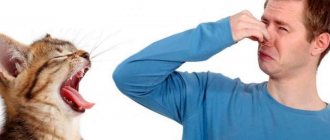When a pet begins to have serious problems with kidney function, this is a disaster for both the furry sufferer and his loving owner. Love for an animal means that the owner will study all the nuances of such a disease as kidney failure in cats, and learn everything about methods of treatment and prevention. So, we are studying the differences in the forms of this disease, how to diagnose and treat them.
What is kidney failure and why is it dangerous?
Kidney failure is very common in cats, although most often the disease manifests itself in older pets as chronic. Unfortunately, the kidneys also have their own resource.
global $ads_google; //data-ad-slot=”2475549904″ $ads_google = empty($ads_google) ? false : true; ?> if ($ads_google == false) {?>
$ads_google = true; ?> } ?>
Kidney disease is one of the most common medical problems in cats. Most often they manifest themselves in older animals in the form of chronic kidney disease, when the kidneys gradually exhaust their resources.
The disease comes in two forms:
- acute;
- chronic.
The second type of disease poses the greatest danger. We study:
Chronic renal failure
In the chronic form, gradual death of kidney cells occurs, which leads to a decrease in these organs in size and disruption of their functioning.
“Chronicle” is not curable, but if the correct therapy is carried out, then stopping the symptoms will significantly prolong the life of your beloved cat.
With this diagnosis, the pet’s condition is characterized as severe, and maintenance therapy cannot be avoided: the cat’s life will need to be maintained with special care and a special diet.
The disease requires regular monitoring by a veterinarian.
Acute renal failure
The acute type is reversible, because with timely treatment, success can be achieved with the complete elimination of all consequences of the disease.
Acute renal failure is a sudden dysfunction of the kidneys, or even its complete cessation. All renal functions are impaired: secretory, excretory, and filtration suffer.
Speaking about the condition of a sick cat, we can say that these will be symptoms of the disease that caused the kidney disorder.
It is difficult to express the initial phase in the clinical picture, because there are no characteristic symptoms as such. Secondary symptoms are disguised as the underlying disease, injury or poisoning. If you delay the start of treatment at this important moment, then you can “give” the cat oliguria (decrease) or anuria (when urine production completely stops).
In acute cases, the animal must be hospitalized immediately and proper treatment must begin. Delay will lead to complications or death.
Acute renal failure: etiology, clinical picture, diagnosis, treatment
Acute renal failure (ARF) is characterized by a rapid decline in glomerular filtration rate (GFR), clinically manifested as a sharp and stable increase in urea and creatinine levels. Life-threatening consequences include fluid overload, hyperkalemia, and metabolic acidosis.
All the reasons that cause the development of acute renal failure can be divided into three large groups:
1. Extrarenal (extrarenal) causes lead to a decrease in blood volume and a sharp decrease in renal blood flow, which can cause irreversible cell death of renal tissue. Extrarenal causes of acute renal failure include: severe extensive operations, especially in weakened or elderly patients; injuries accompanied by painful shock and hypovolemia; sepsis; massive blood transfusion; extensive burns; uncontrollable vomiting; uncontrolled use of diuretics; cardiac tamponade.
2. Renal (renal) causes include ischemic and toxic lesions of the renal tissue, acute inflammation of the renal parenchyma or damage to the renal vessels, which cause necrosis of the renal tissue. Renal causes of acute renal failure include: acute glomerulonephritis; acute tubular necrosis; rheumatic kidney damage; blood diseases; poisoning with mercury, copper, cadmium salts, poisonous mushrooms, organic fertilizers; malignant arterial hypertension; lupus nephritis; uncontrolled use of drugs from the group of sulfonamides, antitumor drugs, aminoglycosides, NSAIDs.
3. Subrenal (postrenal) causes are associated with impaired urine outflow, which leads to accumulation of urine in the collecting system, edema and necrosis of renal tissue cells. Renal causes of acute renal failure include: bilateral obstruction of the ureters by stones or blood clots; urethritis and periurethritis; tumors of the ureters, prostate, bladder; long-term compression of the ureters during trauma, surgical interventions on the abdominal organs.
Depending on the causes of development, prerenal, renal and postrenal acute renal failure are distinguished, respectively.
With acute renal failure, there is a sharp disruption of all functions performed by the kidneys. The loss of the kidneys' ability to maintain the balance of electrolytes in the blood is accompanied by an increase in the concentration of calcium and potassium ions and chlorine, as well as the accumulation of protein metabolic products and an increase in the level of urea and creatinine in the blood. Violation of the secretory function of the kidneys causes the development of anemia and thrombocytopenia. As a consequence of impaired renal excretory function, one of the main symptoms of acute renal failure develops - oliguria (decreased urine output) up to anuria (complete absence of urine). The condition of patients with acute renal failure is usually moderate or severe, disturbances of consciousness occur (lethargy or excessive agitation), swelling of the extremities, cardiac arrhythmias, nausea and vomiting, and an increase in the size of the liver is determined.
We recommend reading: Causes of Seizures in Dogs
The clinical course of acute renal failure is divided into several stages, successively replacing each other.
At the initial stage of acute renal failure, which usually lasts several hours, less often several days, circulatory collapse develops, accompanied by severe ischemia of the renal tissue. The patient's condition may be different; it is determined by the main cause of the development of acute renal failure.
At the stage of oligoanuria, there is a sharp reduction in urine volume (no more than 0.5 liters of urine per day) or a complete absence of urination. This stage usually develops within three days from the onset of acute renal failure, but can extend to 5-10 days. Moreover, the later acute renal failure develops and the longer its duration, the worse the prognosis of the disease and the higher the likelihood of death. With prolonged oligoanuria, the patient becomes lethargic and lethargic, and may fall into a coma. Due to pronounced suppression of immunity, the risk of secondary infection with the development of pneumonia, stomatitis, mumps, etc. increases.
During the diuretic stage, there is a gradual increase in urine volume, reaching about 5 liters of urine per day. The duration of the diuretic stage is usually 10-14 days, during which a gradual regression of the symptoms of renal failure occurs and the electrolyte balance of the blood is restored.
At the recovery stage, further restoration of all kidney functions occurs. It may take 6 months to a year to fully restore kidney function.
Features of treatment of acute renal failure depend on the stage of the disease.
At the initial stage of renal failure, treatment should be aimed at the underlying disease that caused the development of acute renal failure. Anti-shock measures are carried out (increasing blood pressure, replenishing blood volume, supporting cardiac activity), the administration of protein solutions (under the control of central venous pressure) and blood substitutes is indicated. To detoxify the body, gastric lavage, unithiol, and plasmapheresis are used. If acute renal failure is caused by obstruction of the urinary tract, puncture of the pelvis is used to remove excess urine and eliminate swelling of the kidney.
At the oliguric stage of acute renal failure, the use of osmotic diuretics (mannitol, sorbitol) in combination with furosemide is indicated; dopamine is used to reduce vasoconstriction. It is important to restore the volume of circulating fluid and follow a low-protein diet. All appointments are carried out against the background of constant monitoring of blood electrolyte composition, urea and creatinine levels. According to indications, antibacterial drugs and anabolic hormones are used.
In the absence of results from conservative therapy, hemodialysis is indicated for patients.
Didn't find what you were looking for? Use the search:
During the diuretic stage, there is a gradual increase in urine volume, reaching about 5 liters of urine per day. The duration of the diuretic stage is usually 10-14 days, during which a gradual regression of the symptoms of renal failure occurs and the electrolyte balance of the blood is restored.
Causes of the disease
global $ads_google; //data-ad-slot=”2475549904″ $ads_google = empty($ads_google) ? false : true; ?> if ($ads_google == false) {?>
$ads_google = true; ?> } ?>
Owners of some breeds need to be more careful, as the incidence of kidney disease is higher in Persian and Angora cats. But often this is an acquired disorder that occurs for a number of reasons:
- as a result of decreased blood circulation and urine flow to the kidneys;
- high blood pressure levels;
- oncology;
- kidney stones create obstruction;
- poisoning by a number of medicinal and non-medicinal drugs;
- severe oral diseases;
- incorrectly selected diet with a large amount of phosphorus or high protein content.
The following can be said about the acute form. In prerenal acute renal failure, the cause may be shock after bleeding, poisoning, dehydration, or heart failure. There will be a drop in pressure and impaired circulation in the bloodstream of the kidneys. The causes of renal acute renal failure are called bacterial infections, inflammations and infections, poisoning with poisons and chemicals.
In postrenal acute renal failure, urolithiasis develops due to blockage of the urinary tract.
Diet
First of all, you need a balanced diet with a minimum content of protein and phosphorus, which will have to be followed very precisely - the slightest deviation will lead to a deterioration in the animal’s condition. Therefore, it is important to know exactly how and what to feed a cat with kidney failure. It is quite difficult to create a correct diet on your own; most likely, you will have to switch the sick cat to specialized and expensive food. Dry food is contraindicated.
It will be especially difficult to accustom a cat to a new type of food - it will require a lot of patience and time, but it will help prolong the pet’s life. In addition, you may need drugs that stimulate appetite and regulate digestive processes.
Risk group
The risk group includes such factors as the presence of kidney pathology, extensive injuries, serious illnesses, liver pathologies, inflammation of the pancreas, diabetes mellitus, diseases of the cardiovascular system, and hereditary insufficiency.
Cats over 7 years of age are also at risk, especially if they are in a prolonged state of dehydration or fever.
Symptoms of the disease with photos
The symptoms of kidney failure are not so easy to understand. Especially in the chronic form of the disease.
Acute symptoms
If the cause is impaired renal function due to a developing infection, a state of shock, or obstruction of the lower urinary system, then the symptoms and signs of renal failure will be pronounced and the acute form will appear very clearly.
It is especially important if suddenly the cat constantly visits the toilet, but then such visits become rare, although the animal drinks water willingly and a lot.
global $ads_google; //data-ad-slot=”2475549904″ $ads_google = empty($ads_google) ? false : true; ?> if ($ads_google == false) {?>
$ads_google = true; ?> } ?>
At the same time, the cat may experience diarrhea, nausea or vomiting. This all leads to weight loss.
Externally, the pathology manifests itself in a deterioration in the quality of wool. The mucous membranes may turn red, swelling appears, and appetite disappears.
All these symptoms should immediately alert the owner and it would be best to take the patient and go with him to a veterinary hospital to make an accurate diagnosis.
Symptoms of the chronic form
The insidious variety is characterized by a hidden course, which greatly complicates the diagnosis without veterinary experience.
Signs of chronic renal failure include increased thirst with an increase in urine volume, simultaneous loss of body weight and loss of appetite. Vomiting may occur, and the general condition is lethargic. An unpleasant odor will be heard from the mouth.
Skin turgor becomes weak, folds do not straighten out for a long time. The temperature is lowered, the kidneys can be felt by palpation due to their increased size.
Prevention of kidney disease in cats
Kidney disease in cats is much easier to prevent than to treat and deal with complications. The most effective preventive measures are:
- the cat should always have free access to clean, fresh water;
- Any products that are potentially hazardous to its health (sweets, pickles, smoked foods, etc.) should be excluded from the animal’s diet;
- The cat's menu should consist of foods rich in vitamins and minerals, the proportion of protein should be reduced to optimal depending on the level of activity of the animal;
- it is imperative to maintain a high level of physical activity for the cat, provide it with walks in the fresh air and create conditions that stimulate the desire to play, imitate hunting, etc.;
- it is necessary to promptly contact a veterinarian if there are any changes in the behavior or health status of the cat;
- Regular preventive examinations are required (especially animals predisposed to diseases of the urinary system need them);
- the animal must undergo vaccination to reduce the risk of developing infectious diseases;
- If a cat has already developed kidney disease, after a course of treatment prescribed by a doctor, it is necessary to take medications that reduce the likelihood of relapse. One of them is “UROLEX” - urological drops with a natural composition. They can be used for animals of any age, as well as for pregnant and lactating cats. "UROLEX" helps restore kidney function and helps reduce the likelihood of developing congestion and inflammatory phenomena that provoke the formation of stones.
It is important to understand that the listed actions are effective only if they are carried out systematically. A comprehensive approach to preventing kidney disease will help give your pet a long and happy life.
Diagnostics
Renal failure in cats can be reliably diagnosed if clinically possible. For diagnosis, you need to take a urine and blood test and undergo an ultrasound.
Laboratory studies are indicative. Blood biochemistry will reveal increased levels of creatinine, urea and other components, but calcium, on the contrary, will be reduced and acidity increased.
If this is acute renal failure, then a urine test will reveal protein and the presence of dead renal epithelium, glucose, and red blood cells. With chronic renal failure, urine will have a low specific gravity and density, protein will be very difficult to determine, but dystrophic cells of the tubular epithelium will be noticeable.
The results of a general blood test in the acute form will not show any peculiarities, but in the chronic form, anemia and an increased number of ESR will be revealed.
An ultrasound of the kidneys will show a changed structure of the organ, stones and tumors. If the form of the disease is acute, then the kidneys will be enlarged with edema, and in the chronic case, on the contrary, a strong decrease in the size of the organs and an uneven and clear contour will be shown.
It happens that a veterinarian suggests examining a pet for possible kidney problems even though there seem to be none. You shouldn’t refuse, because you can detect problems at an early stage, which significantly simplifies the situation and gives many chances for a cure.
global $ads_google; //data-ad-slot=”2475549904″ $ads_google = empty($ads_google) ? false : true; ?> if ($ads_google == false) {?>
$ads_google = true; ?> } ?>
At home, an accurate diagnosis cannot be made based only on symptoms.
Kidney Failure in Cats: Symptoms and Signs
Kidney failure may not manifest itself for a long time, and only after about 70% of the kidneys' performance is lost does the disease make itself felt. The early stages of the disease are accompanied by changes in the composition and color of the animal's urine. Do you have even the slightest doubt about this issue? It is better to immediately conduct a special laboratory analysis.
Keep a close eye on your pet
The following symptoms will help you recognize kidney failure in cats:
- weakness, bad breath, refusal to eat and play actively;
- drinking large amounts of water and urinating frequently;
- diarrhea, vomiting, painful cramps (often appear at the terminal stage of the disease);
- spontaneous increase in blood pressure, ruptures of blood vessels in the eyes;
- elevated body temperature, tremors, strange behavior.
The more the body is exposed to toxins, the more pronounced the signs of kidney failure become. It is also recommended to sound the alarm in advance if you initially know that your pet has ailments such as diabetes, pneumonia, piroplasmosis, and enteritis.
Treatment of cat kidney failure
Since the condition of a cat with acute renal failure is different from the condition with chronic renal failure, the treatment processes will be different.
The most common sense decision if you suspect kidney failure in cats is to visit a veterinarian. Do not ignore the advice of a veterinarian:
If we are talking about an acute form, then intensive therapy will be carried out to remove toxins and combat dehydration.
If a chronic form is detected with damage to two-thirds of the kidneys, then treatment is prescribed only by a specialist.
Hospital treatment is prescribed for acute renal failure, as it is life-threatening. The process is designed for 10-14 days. Veterinarians will eliminate the main cause of the disease. If this is a blockage of the outflow of urine by a stone, then it will be removed by a catheter.
After this, the underlying pathology will be treated with intravenous infusions, which will eliminate problems with water-salt metabolism and acidosis. At the same time, cardiac activity, which suffers from excess potassium, is maintained.
Diuresis is stimulated, and sometimes peritoneal dialysis is performed to remove toxins. The abdominal cavity and drainages are involved in this - this will significantly reduce the load on diseased kidneys.
With inpatient treatment, the result can be the most positive with complete preservation of the functionality of the organs, but it is not particularly rosy if the patient gets to the doctors late. In this case, the cat faces a chronic form of the disease. The chronic form is treated in a hospital during relapses or complications.
In case of severe damage, kidney transplantation is possible.
A therapeutic diet will be prescribed, which will need to be strictly followed throughout the pet’s life. Even with serious damage, you can extend your pet’s life by three years, while alleviating its condition.
At home
global $ads_google; //data-ad-slot=”2475549904″ $ads_google = empty($ads_google) ? false : true; ?> if ($ads_google == false) {?>
$ads_google = true; ?> } ?>
At home, you will need to maintain your body and kidney function in the best possible condition. You will need to study the recommended cat diet and create a strict diet where the phosphorus content is minimal.
Everything else is done strictly according to the veterinarian’s recommendations, with frequent visits to the clinic, examinations and tests.
Drugs for renal impairment
It cannot be assumed that there is a general treatment regimen for everyone; it is selected taking into account the individual characteristics of each pet. Therefore, such schemes are changeable and aimed at precisely eliminating symptoms and causes.
In case of uremia, high intoxication from nitrogen metabolism products, a low-protein diet is introduced. In between meals, Ringer's solution or saline solution (0.9% NaCl) should be administered with a volume of up to 40 ml per 1 kg of body weight. Three administrations per day will be required.
If an excess of phosphorus levels in the blood is detected, then not only a diet is needed, but also the intake of phosphate binders that bind phosphorus. The drug is given with meals.
When the level of parathyroid hormone is elevated, calcitriol medications are prescribed.
Uncontrollable vomiting can be treated with Cerucal, but not on a permanent basis. It will be necessary to include histamine receptor blockers in the regimen: this is taking Famotidine, Cimetidine.
If there is acidosis, then the regimen cannot do without sodium bicarbonate and potassium citrate.
If high blood pressure is expressed, it is reduced in the absence of dehydration with Amlodipine, Enalapril.
The potassium balance is also brought back to normal; for this purpose, potassium preparations are introduced into the menu.
The kidneys are supported with drugs containing amino acids such as Lespenefril, Ketosteril, Chophytol, Canephron.
You can’t do without a vitamin component, sedatives, and if indicated, corticosteroids and diuretics.
CRF in cats
4598Pavel
Pathological changes in a pet’s body often lead to the occurrence of such an insidious disease as kidney failure in cats. Its insidiousness lies in the fact that symptoms may not appear for quite a long time. The clinical picture of the disease becomes obvious when there is significant damage to the kidney tissue.
Kidney failure is characterized by disturbances in the functioning of the urinary system, which affects the entire body of the cat. Therefore, it is important to recognize the disease as early as possible in order to prescribe correct and timely therapy. This will help save the health and life of the cat. Let's talk about the symptoms and treatment of kidney failure.
© shutterstock
Causes of kidney pathologies
The most common causes of disease in cats include::
- kidney damage of an infectious and bacterial nature;
- frequent inflammatory kidney diseases, as well as the result of improper therapy or its incomplete course;
- kidney damage as a result of toxic poisoning;
- congenital pathologies and genetic predisposition;
- tumors of various types (malignant or benign) affecting kidney function.
Note that some cat breeds are born with a predisposition to kidney failure. For example, representatives of the Persian breed suffer from polycystic kidney disease, which significantly shortens their life. Even with timely and competent therapy, the pathology cannot be cured. It is transmitted even to those kittens that have only breed admixtures. Abessinian cats suffer from protein metabolism disorders; it is incurable, shortens the pet’s life and worsens its quality.
Renal failure, classification and course of the disease
You should know that this disease cannot be completely defeated. Timely therapy will only stop its progression and prolong the cat’s life. Any inflammatory process or poisoning can lead to kidney failure.
© shutterstock
There are two forms of kidney failure in cats:
- Spicy . Sudden damage to organ tissue leads to the immediate manifestation of symptoms of the disease. This allows you to immediately take measures aimed at treatment, which, as a rule, gives an excellent result, even allowing you to completely restore the tissue of the affected organ.
- Chronic . The slow progression of the disease ultimately leads to severe damage to the kidney tissue. There is a decrease in renal blood supply and the organ is no longer able to recover. Treatment of a cat is aimed only at curbing the development of the disease. If it is not recognized or therapy is neglected, then the cat is doomed to death.
They distinguish the gradual development of chronic renal failure in cats:
- first, there is a sharp drop in blood pressure and retention of urine;
- then urine does not come out at all, thereby poisoning the cat’s blood with nitrogenous compounds;
- the last stage of failure is characterized by the outflow of urine. But since the kidneys cannot cope with their functions of removing harmful substances from the body, the water entering the cat’s body comes out in the same form.
Symptoms of the disease
Kidney failure, especially in chronic form, is quite difficult to recognize. Many of its symptoms can be mistaken for another disease. The diagnosis of chronic renal failure can be made after testing urine and blood in the laboratory. Let us indicate the symptoms of kidney failure that may appear in a cat :
- loss of appetite and sudden weight loss;
- the cat’s activity decreases (often owners do not attach importance to this if the cat is already at a considerable age);
- pallor of the mucous membranes;
- fluctuations in body temperature;
- urination stops or, conversely, the need to drink increases, and the cat urinates frequently;
- breath becomes with an ammonia smell, salivation increases;
- swelling of the paws is noted first, then they rise higher;
- against the background of dehydration of the body, the mucous membranes become dry, the coat loses its shine;
- You may experience bloody vomiting or blood in your stool.
© shutterstock
Acute renal failure
There are several types of acute kidney pathology:
- viral and bacterial kidney diseases, as well as severe infectious processes;
- poisoning with drugs and snake venom;
- damage to kidney tissue by salts of heavy metals, aniline, etc.
- Prerenal failure. The occurrence is associated with a state of shock and occurs with a reduction in blood flow through the cat’s kidneys. The reasons may be:
- exposure to heat or sun leading to severe overheating;
- acute cardiovascular disorders;
- severe infections or severe poisoning;
- severe dehydration;
- shock due to injury and heavy bleeding.
Postrenal failure. Associated with compression of the organs of the urinary system or their mechanical blockage due to trauma to the pelvic organs, tumors or urolithiasis.
© shutterstock
Symptoms of acute renal failure appear very quickly in a cat, which makes it possible to recognize them and contact a veterinarian as soon as possible. After examining and studying the tests, the doctor prescribes therapy, the result of which allows the cat to continue to live a full life.
Chronic renal failure
The disease develops gradually, without showing any symptoms associated with severe damage to the kidney tissue, up to serious destruction of the organ. Therefore, deficiency is often observed in older cats. Among the causes of the disease are :
- pathological diseases of a metabolic nature (protein metabolism disorders or the presence of diabetes mellitus);
- lack of treatment for the acute form of the disease or insufficient therapy;
- chronic viral or bacterial kidney infections;
- congenital or genetic predisposition;
- urolithiasis disease;
- tumor manifestations.
The actions of a veterinarian when symptoms of chronic renal failure are detected are aimed at clinical examination of blood and urine, as well as establishing the causes of the disease. Therapy will be aimed at alleviating the pet’s condition and curbing the development of the disease. A cure cannot be achieved due to significant damage to the organ tissue, but it is possible to prolong the cat’s life.
Treatment of kidney failure in cats
If acute renal failure is detected, round-the-clock treatment and observation of the cat will be required in a veterinary clinic. The first aid will be to drain urine from the bladder, for which a catheter is inserted. Then a course of drips and injections is prescribed, aimed at :
- restoration of salt balance,
- reducing pressure.
© shutterstock
If infection is present, treatment is with antibiotics.
Acute failure is usually accompanied by pain, for the relief of which the doctor recommends appropriate medications. The cat is fed through a tube. Only after the pet’s condition improves and is ready to eat on its own is it transferred to medicated food.
Chronic renal failure in a cat requires the use of a diet selected by a veterinarian on an individual basis. Treatment consists of restoring blood pressure, vitamin balance, and reducing body intoxication. Drug therapy in combination with herbal renal infusions helps in this regard.
Preventive actions
Any disease is easier to cure if it is recognized at an early stage. Therefore, the first priority measures in the prevention of kidney failure will be annual examinations of the pet at a veterinary clinic with the donation of urine and blood for testing. For older cats, such tests should be done once every six months.
Clinical studies can indicate the presence of the disease at an early stage, which will facilitate treatment and give a chance to restore and prolong the normal life of the cat. If this is not done, then there is a risk of the animal dying from this insidious disease.
The second preventive measure can be called nutrition, which should be correct and as balanced as possible. Therefore, cat owners often choose industrially produced food, where the ingredients are carefully selected. It should be noted that there is no need to save on them and purchase high-quality feed from trusted manufacturers. At the same time, give preference to wet products or, when using dry ones, ensure sufficient drinking.
IMPORTANT!
VETERINARIAN CONSULTATION REQUIRED. INFORMATION FOR INFORMATION ONLY.
Share with friends
Article rating
Cat diet and nutrition
Proper nutrition for kidney failure will significantly alleviate the cat’s condition, improve the pet’s quality of life and increase its duration. It is best to contact your veterinarian for a specific list of permitted products.
global $ads_google; //data-ad-slot=”2475549904″ $ads_google = empty($ads_google) ? false : true; ?> if ($ads_google == false) {?>
$ads_google = true; ?> } ?>
Special food is available for cats with this disease. Their composition is optimal as a food product. The phosphorus component must be limited, which will have a positive effect on the rate of organ destruction.
From ready-made food for kidney failure, you can purchase:
- Royal Canin Renal low phosphorus and protein;
- Hills Prescription Diet K/D Feline Renal Health with Omega-3;
- Farmina Vet Life Renal with the required protein content as a medicinal feed.
The composition of such feeds is balanced and optimal in content. You can purchase wet or dry food to suit your pet's taste. The advantage of this choice will be a ready-made selection of the amount of phosphorus and protein, which is very difficult to do when feeding natural products.
When a pet is fed natural food, the intake of sodium, which contributes to arterial hypertension, is limited. A cat can eat chicken breast, turkey, rabbit meat, and vegetables.
Diet for chronic renal failure
Regardless of the cause of chronic renal failure, animals are prescribed a diet. Kotofey food should be low in calcium, sodium, phosphorus and proteins. You should not give your cat cheese, egg yolks, bones, or meat by-products. The more advanced the kidney failure, the more dietary restrictions there are. They cannot be neglected (the pet will become worse), and it is difficult to choose food taking into account all the nuances of the diet. In this case, there are special medicinal foods for cats with kidney disease. They contain a reduced content of undesirable substances and an increased dose of components the cat needs: soluble fiber, B vitamins, etc.
You can choose medicinal food and medications for your pet on the website of the Pharmmed veterinary pharmacy.
Anastasia Lemenkova
Forecasts
If the disease is detected in a timely manner and treatment is started on time, the prognosis is more favorable. If we are talking about the acute variety, then the situation is better: hospital treatment and a therapeutic diet can really work a miracle.
When they talk about the chronic variety, they immediately notice that everything depends on the pet’s immunity, supportive therapy, timeliness of treatment and the causes of the disease.
That is why it is important to realize the full responsibility for his life and follow all the veterinarian’s recommendations. In this case, the cat is able to live a longer life, full of love and care.
Video on the topic:









